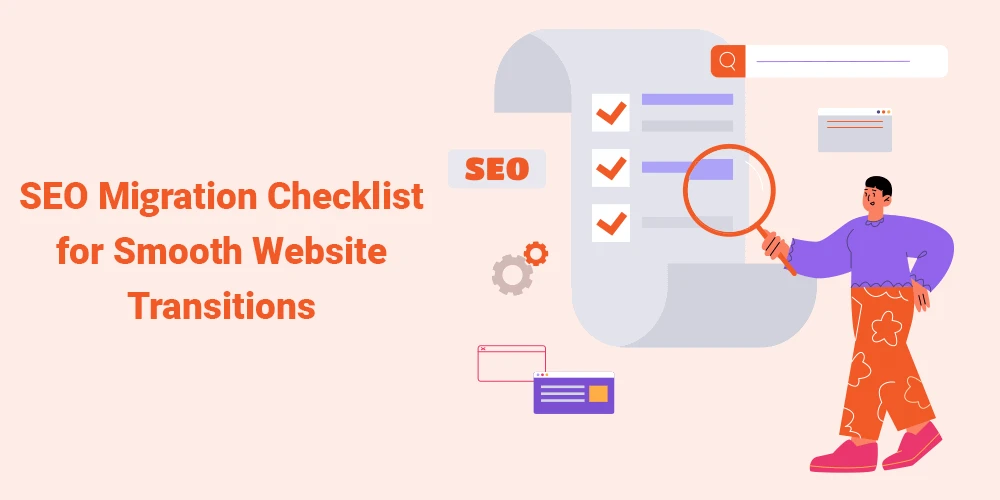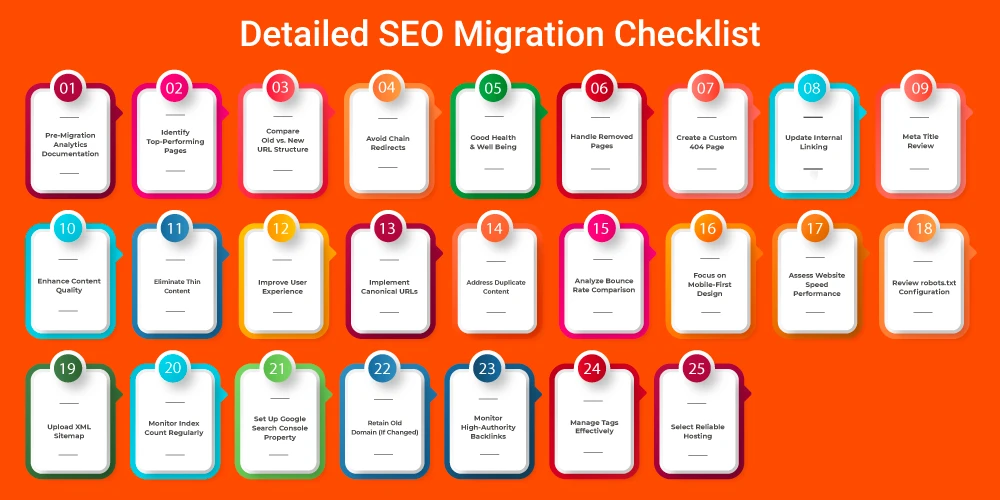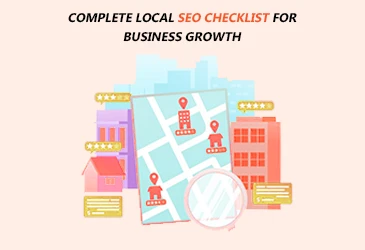25-Step SEO Migration Checklist
Updated : January 29, 2025

Migrating your website can feel like a daring task filled with potential challenges. No matter if you're redesigning your site, switching platforms, or changing your domain, the stakes are high.
A successful migration can elevate your online presence, while a misstep can sink your hard-earned SEO rankings and traffic.
But fear not! Our meticulously designed SEO migration checklist is here to be your compass. With each step clearly outlined, you’ll complete this complex process with ease and confidence.
What is an SEO migration?
An SEO migration refers to the process of transitioning a website from one platform, structure, or domain to another while ensuring that its search engine optimization (SEO) elements are preserved or improved. This process can involve:
- Changing Domains: Moving a site to a new domain (e.g., from example.com to newexample.com).
- Website Redesigns: Overhauling the site's layout or design while maintaining the same domain.
- Platform Changes: Switching content management systems (CMS), like moving from WordPress to Shopify.
- URL Structure Changes: Modifying the way URLs are formatted (e.g., from example.com/category/page to example.com/page).
How long should a SEO migration take?
The approximate total time for an SEO migration can range from 4 to 10 weeks. This includes planning (1-2 weeks), implementation (2-4 weeks), testing (1-2 weeks), and launch (about 1 week), with ongoing monitoring continuing indefinitely after the launch. The specific duration will depend on the complexity and size of the website being migrated.
Detailed SEO Migration Checklist
Migrating a website can significantly impact its SEO performance if not done carefully. This detailed checklist will guide you through the migration process, ensuring you preserve and enhance your search engine rankings.

-
Pre-Migration Analytics Documentation
- Current Performance Assessment: Use tools like Google Analytics to gather comprehensive data on traffic, user behavior, conversion rates, and engagement metrics. Understand which pages and content types are performing best.
- Benchmarking: Establish a baseline for key metrics such as organic traffic, bounce rate, and conversions to measure the success of your migration.
-
Identify Top-Performing Pages
- Key Pages List: Analyze data to identify pages with the highest traffic, engagement, and conversion rates. Make a list of these pages to prioritize during the migration.
- Preserve Value: Document the URLs and ensure they receive proper redirects to maintain their search visibility.
-
Compare Old vs. New URL Structure
- Mapping Strategy: Create a detailed map of old URLs and their corresponding new URLs. This will help avoid broken links and loss of SEO equity.
- Structure Consistency: Ensure the new URL structure is logical and user-friendly. A clean, organized URL structure enhances both SEO and user experience.
-
Avoid Chain Redirects
- Direct Redirects Implementation: Set up 301 redirects that lead directly from the old URL to the new URL, avoiding any intermediary redirects. This maintains link equity and improves load times.
-
Redirect All Updated URLs
- 301 Redirects: Implement 301 redirects for all URLs that have changed to ensure search engines and users are directed to the correct pages.
- Testing Functionality: Regularly test all redirects to confirm they are functioning correctly and leading to the intended pages.
-
Handle Removed Pages
- Decide on Approach: Determine how to handle any removed pages. Use 301 redirects for related content or return a 410 status for permanently deleted content.
- User Communication: Provide a clear path for users to find relevant information, even if some pages are removed. Consider adding links to similar or popular content.
-
Create a Custom 404 Page
- User-Friendly Design: Design a 404 error page that is visually consistent with your brand. Include links to popular or related content to help users navigate.
- Search Options: Incorporate a search bar or a sitemap to assist users in finding what they’re looking for.
-
Update Internal Linking
- Link Audit: Review your internal links and update them to reflect the new URL structure. This is crucial for maintaining crawlability and user experience.
- Crawlability Check: Ensure all internal links are functional and lead to relevant, updated content. Use tools like Screaming Frog or Sitebulb for audits.
-
Meta Title Review
- Check Titles: Review and optimize meta titles for all pages, ensuring they are descriptive and aligned with the content.
- Keyword Integration: Incorporate relevant keywords to improve search visibility and click-through rates.
-
Enhance Content Quality
- Quality Check: Evaluate existing content for relevance, accuracy, and engagement. Identify areas for improvement or expansion.
- Update and Revise: Refresh outdated content and enhance it to better meet user intent. Aim for higher word counts and depth where necessary.
-
Eliminate Thin Content
- Content Audit: Identify pages with low word count or minimal value. Use tools like Google Analytics or SEMrush for analysis.
- Consolidation Strategy: Consider merging thin pages with higher-value content or rewriting them to add substance.
-
Improve User Experience
- Design Review: Ensure the new site design enhances navigation and usability. Focus on intuitive layouts and clear calls to action.
- Mobile Responsiveness Testing: Verify that the new site is mobile-friendly and provides a seamless experience across all devices using Google’s Mobile-Friendly Test.
-
Implement Canonical URLs
- Canonical Tags: Use canonical tags to prevent duplicate content issues, especially if similar content exists in multiple locations.
- Define Primary Versions: Clearly indicate the preferred version of each page to search engines.
-
Address Duplicate Content
- Content Review: Identify duplicate content issues both pre- and post-migration. Use tools like Siteliner to assist in this process.
- Resolution Strategy: Modify, combine, or remove duplicate content as necessary to improve SEO.
-
Analyze Bounce Rate Comparison
- Post-Migration Monitoring: Compare bounce rates and other engagement metrics before and after migration to assess user engagement.
- Engagement Optimization: Make adjustments based on data to improve user experience and reduce bounce rates.
-
Focus on Mobile-First Design
- Mobile Optimization: Prioritize mobile user experience in design and functionality, as mobile-friendliness is crucial for SEO.
- Performance Testing: Regularly test mobile performance using tools like Google PageSpeed Insights.
-
Assess Website Speed Performance
- Speed Test: Conduct thorough speed tests using tools like GTmetrix or Google PageSpeed Insights to identify any performance issues.
- Asset Optimization: Optimize images, minify CSS/JavaScript, and leverage browser caching to enhance loading times.
-
Review robots.txt Configuration
- Check File: Update the robots.txt file to ensure that search engines can crawl the new site effectively.
- Avoid Blocking Issues: Double-check for any disallow rules that could prevent important pages from being indexed.
-
Upload XML Sitemap
- Generate New Sitemap: Create a new XML sitemap reflecting the updated URL structure. Use tools like Yoast or Screaming Frog to generate sitemaps easily.
- Submission to Search Engines: Submit the new sitemap to Google Search Console and Bing Webmaster Tools to facilitate indexing.
-
Monitor Index Count Regularly
- Check Indexing Status: Regularly monitor the index count in Google Search Console to ensure all important pages are indexed.
- Address Indexing Issues: Investigate and resolve any significant drops in indexed pages promptly.
-
Set Up Google Search Console Property
- New Properties Setup: Add the new site as a property in Google Search Console for tracking and insights.
- Verify Ownership: Ensure proper verification to gain access to performance reports and troubleshooting tools.
-
Retain Old Domain (If Changed)
- Domain Retention Strategy: If changing domains, keep the old domain active for at least a year to capture residual traffic and manage redirects.
- Renew Domain: Make sure the old domain is renewed and functional throughout the transition.
-
Monitor High-Authority Backlinks
- Track Existing Backlinks: Use tools like Ahrefs or Moz to monitor backlinks to your top-performing pages.
- Outreach Efforts: Reach out to webmasters of high-authority sites to update links pointing to the old URLs.
-
Manage Tags Effectively
- Review Tags: Audit existing tags on your site and optimize them for better organization and relevance.
- Consistent Tagging Strategy: Ensure consistent use of tags across your site to enhance internal linking and user navigation.
-
Select Reliable Hosting
- Choose Quality Hosting: Select a hosting provider known for high uptime, speed, and excellent customer support.
- Performance Monitoring Post-Migration: Continuously monitor site performance after migration to address any hosting-related issues quickly.
By following this detailed checklist, you can mitigate risks associated with website migration and improve your site's SEO performance during and after the transition. Keep an eye on your site's analytics and user feedback to make informed adjustments as necessary.
Kaizen Global’s Guide: Embrace Your Migration Journey
A well-executed SEO migration can pave the way for growth and innovation, keeping your brand competitive and visible.
At Kaizen, we believe in continuous improvement, which applies to every aspect of your online strategy. As you navigate your migration journey, remember that careful planning and execution are your best assets.
Trust the process, stay committed to your goals, and watch your brand thrive in the ever-evolving digital arena.
Take control of your smart contract security - Request a professional Smart Contract Audit today and ensure the solidity of your blockchain projects
Insights

Local SEO Checklist: Maximize Your Local Reach
Local search engine optimization (SEO) has become essential for businesses aiming to connect with their community and attract nearby ...

On- page SEO Checklist for Optimal Performance
On-page SEO refers to the optimization strategies that can be implemented directly on your website’s pages. Proper on-page SEO ...

Ecommerce SEO Checklist: 21 Essential Strategies
To truly thrive, your eCommerce site needs to be easily discoverable by potential customers. This is where Search Engine Optimization ...